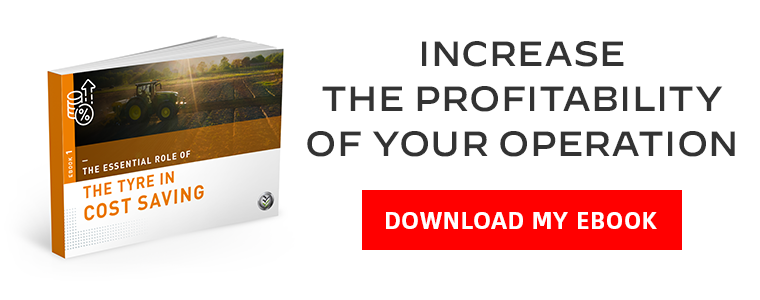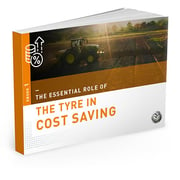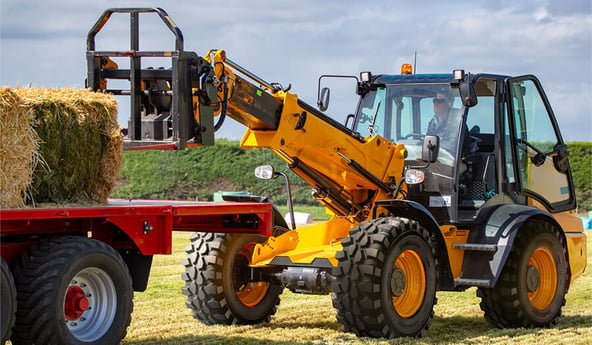Why is the choice of tyre size so vital? The contact patch between the tyres of a tractor and the ground may not seem significant, but this is where the key to vehicle performance lies.
Whether for the transmission of engine power, ensuring good traction or protecting your soil, the choice of tyre has an influence on your productivity, your yield and, at the end of the day, on your profitability.
Do you hesitate between wider tyres, more resistant models or the cheapest option? Would you like to know how to optimise your tractor capacity based on your actual needs?
This comprehensive article explains it all, from the ideal size to match the power of your vehicle to the adjustments necessary to ensure perfect compatibility with your tractor. Discover how a simple change of tyres can improve yields, extend the lifespan of your equipment and optimise your profitability.
1. What width of agricultural tyre to choose?
What is the nominal section width?
The nominal section width of an agricultural tyre indicates its width as measured from one sidewall to the other when not inflated. It’s the first number that you see marked on the sidewall of a tyre.
For example, for a tyre with “520/85 R38” on the sidewall, the “520” corresponds to the tyre width in millimetres.
But bear in mind that on standard tyres, this is not the exact width in contact with the ground, which tends to be less than the width from sidewall to sidewall.
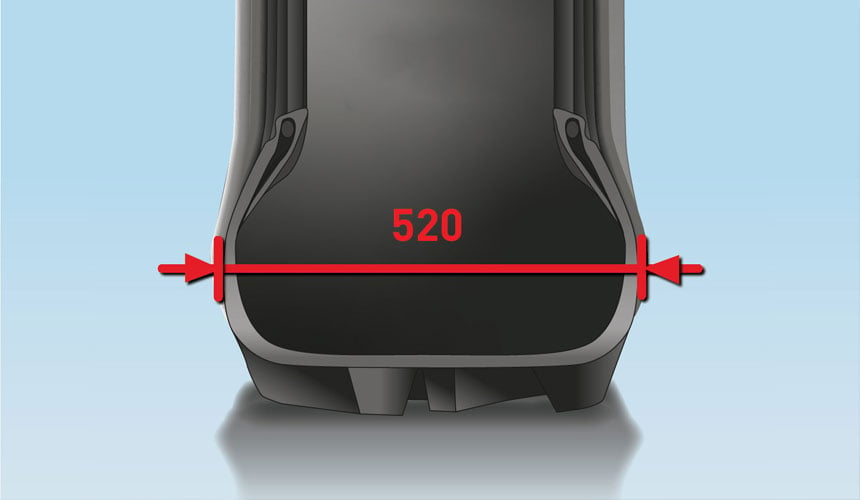
Factors that influence the effective width on the ground
The level of inflation pressure
The lower the pressure, the more the tyre flattens out on the ground, thus increasing the contact area and allowing the entire width of the tread to be used to the full. This is particularly useful for reducing soil compaction and improving traction.
The tyre fabrication technology
Certain tyre models such as VF tyres are designed to operate at low pressure without compromising the load capacity. These tyres offer a larger soil footprint than standard tyres.
New tyre models such as Bridgestone’s VX-R TRACTOR tyre have been engineered to offer a much more accurate correspondence between the nominal section width and the actual width in contact with the ground.
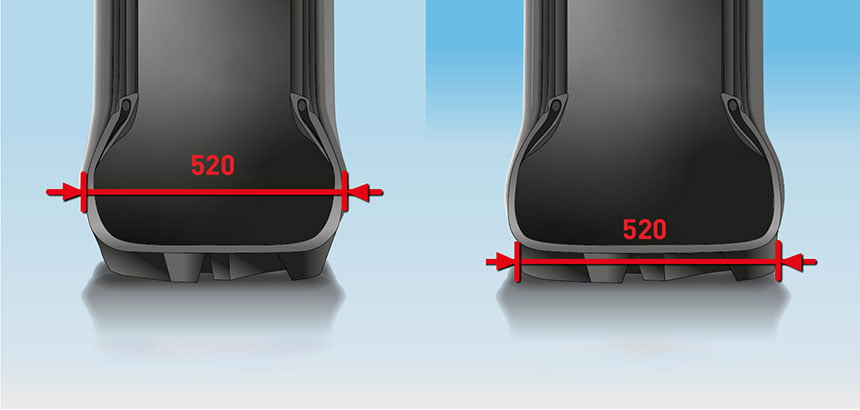
What are the advantages of choosing a wider tyre than was originally fitted on your tractor?
- Better weight distribution to the ground
A wider tyre spreads the weight of the tractor over a larger surface area, which reduces the pressure exerted on each ground point. This limits soil compaction, which is essential for maintaining the fertility of your land and encouraging crop root development. - Working at a lower inflation pressure
A wider tyre can work with a lower inflation pressure if you don’t increase the load. This allows you to protect your soil better. - Increase in load capacity
A wider tyre contains a higher volume of air and therefore increases your load capacity. You can work with wider implements which improve your productivity. - Better traction in wet conditions
A larger contact area improves the tyre’s adherence to the ground. The full width of the lugs grip onto the ground simultaneously, which reduces the risk of slip, especially in wet conditions. This means that you can work more efficiently and reduce the amount of fuel required.
2. What are the dimensions of your rims?
What is the rim width?
The rim, the metal part which supports your tractor tyre, has very precise characteristics. One of the most important of these is its width. Expressed in inches, it corresponds to the distance between the two inner edges of the rim.
Why is this width important? It essentially determines the dimensions of the tyres that can be fitted. A rim that is too narrow cannot be fitted with a wide tyre, and vice versa.

2. Width of the rim in inches, which is the number associated with the profile: W15, DW23, TW18…
Choice of tyres based on your rim:
What tyre sizes are possible if you keep the same rim?
Once you know the dimensions of your rim (width and height) you can consult the tyre manufacturers’ correspondence tables. These tables show the different tyre sizes compatible with your rim.
In general, it is possible to fit slightly wider tyres on the same rim. For example, if you have a W13×28 rim, you may be able to fit a 420/70 R28 tyre instead of a 380/85 R28 tyre. However, it is important to follow the tyre manufacturer recommendations to remain within the acceptable tolerance limits.
The particular case of NRO tyres
Certain more high-tech tyres such as VF tyres may have an NRO option (Narrow Rim Option) which makes it possible to fit wider tyres on rims that would have been too narrow for standard tyres.
The suppleness of the sidewalls and the design of the casing provide greater flexibility and provide the opportunity to opt for bigger, high-tech tyres without investing in wide rims.
The advantages of changing your rims
With wider rims you can fit wider tyres
Wider rims offer many benefits:
- a better weight distribution,
- a reduction in soil compaction,
- better traction, etc.
By changing rims to accommodate wider tyres, you can optimise tractor performance levels.
Reduce the diameter of the rims with greater width
Reducing the diameter of the rim will enable a considerable increase in the volume of air contained in the tyre and either allow for a greater load capacity or limited inflation pressure, for soil preservation purposes.

3. What load are you aiming for?
The load that you wish to carry with your tractor is a decisive element in your choice of tyres. Each tyre is effectively designed to bear a certain load, and if you wish to increase the load, you need to move on to a larger size of tyre.
Why is the load important?
The load index marked on your tyre sidewall indicates the maximum weight that a tyre can carry at a given speed. It contains a number followed by a letter.
For example:
For a 580 / 70 R38 tyre with a load index and speed rating 160 D / 157 E.
At a nominal pressure of 1.6 bar, it can carry 4065 kg (load index = 160) at 50 km/h (speed rating = D) or 3525 kg (load index = 157) at 70 km/h (speed rating = E).
This load index is important; if you overload your tyres you run the risk:
- Of damaging the tyres: the sidewalls will distort excessively, the structure of the tyre is placed under too much strain and in extreme cases the tyre may burst.
- Of reducing the tyre lifespan: too much load accelerates wear to the tyre lugs resulting in more frequent tyre replacement required.
- Of reducing traction: an overloaded tyre needs to have high pressure to cope with the load; it will tend to sink further into the ground, which reduces its traction capacity and increases slip.
- Of increasing fuel consumption: an overloaded tyre has more rolling resistance which leads to higher fuel consumption.
Choice of tyre depending on the load

Identify the load represented by your front implements before choosing your tyres
It is essential to evaluate the load that each implement will represent in addition to the weight of your tractor. You can consult the manufacturer’s technical data sheets or carry out weighing operations if necessary to help with your evaluation.
VF tyres: why are they more suitable for heavy loads?
VF tyres are designed to carry heavy loads at a lower inflation pressure than standard tyres; their structure is much more resistant, which allows them to carry up to 40% more load. They allow for a better distribution of the load. They increase the tyre footprint on the ground, resulting in reduced pressure to the ground despite the load as well as limited soil compaction.
Pressure management to optimise the load:
Beyond the choice of tyre, it is necessary to adjust pressure based on the mounted implement and the load transfer.
Tyre pressure must be adapted to the actual load. A correspondence table supplied by the tyre manufacturer indicates the inflation pressure required based on load and speed.
The importance of correct pressure settings:
- Insufficient pressure can lead to the distortion of the tyre and to premature wear.
- Too much pressure increases rolling resistance, leads to much higher fuel consumption and reduces traction.
4. Which tyre for which tractor depending on size and power?
The choice of tyre size depends on several factors such as the size and the power of the machine, the type of farm and the kind of operations that you carry out.
Extra-wide 900 mm tyres, for example, are perfectly suited to field crop farms of over a hundred hectares. These tyres offer a high load capacity and better traction.
More standard 580 mm tyres can also be very efficient, but for medium-size farms, as obviously they cannot carry the same load.
Below is a selection of practical examples with the most suitable tyre fitting possibilities for specific levels of tractor power:

John Deere 6R 250
270 hp – Tare weight: 7900 kg
| Front dimensions |
Profiles and technology | Rim width | Performance index | Rolling circumference (mm) | Pressure 1 bar at 15 km/h high torque | Pression 1.4 bar at 50 km/h |
| 420/85 R30 | VX | DW 15 | 145 D | 4400 | 2080 kg | 2785 kg |
| 480/70 R30 | VX | DW 15 | 147 D | 4442 | 2190 kg | 2485 kg |
| 540/65 R30 | VX | DW 16L | 150 D | 4422 | 2465 kg | 2690 kg |
| 540/65 R30 | VT (VF) | DW 18L | 155 D | 4437 | 2960 kg | 3450 kg |
| 600/65 R28 | VT (VF) | DW 21B | 159 D | 4406 | 3430 kg | 4050 kg |
| Rear dimensions |
Profiles and technology | Rim width | Performance index | Rolling circumference (mm) | Pressure 1 bar at 15 km/h high torque | Pression 1.4 bar at 50 km/h |
| 650/85 R38 | VX | DW 23B | 173 D | 6168 | 4650 kg | 4320 kg |
| 650/85 R38 | VT (VF) | DW 23B | 179 D | 6071 | 5710 kg | 7065 kg |
| 710/70 R42 | VX | DW 23B | 173 D | 6209 | 4660 kg | 5360 kg |
| 710/70 R42 | VT (VF) | DW 25B | 179 D | 6106 | 5710 kg | 7065 kg |
| 800/70 R38 | VT (VF) | DW 27B | 184 D | 6094 | 6630 kg | 8205 kg |
| 900/60 R38 | VT (VF) | DW 30B | 183 D | 6026 | 6630 kg | 8040 kg |
These dimensions are merely given as examples. If you cannot find the right dimensions, don’t hesitate to consult your usual tyre dealer to obtain a complete list of all available sizes.
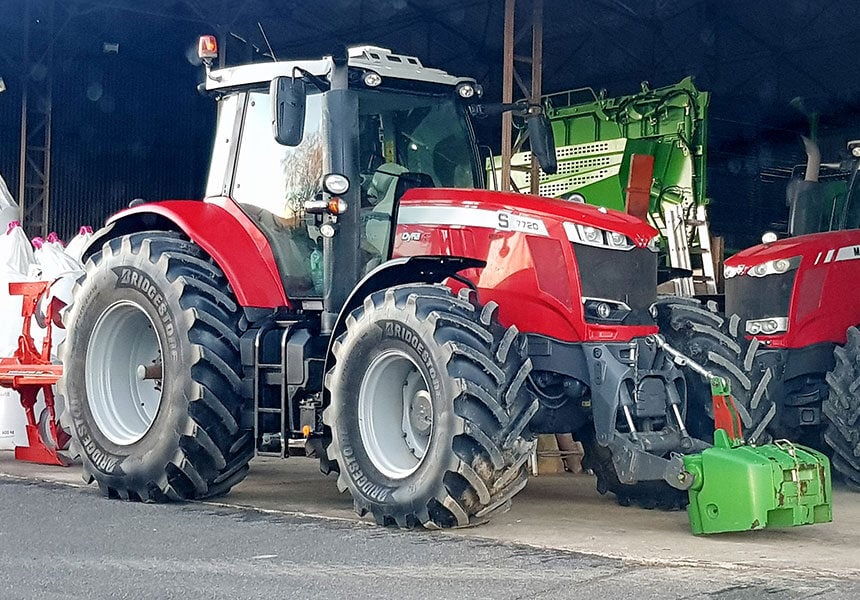
Massey Ferguson 7720
215 hp– Tare weight: 7500 kg
| Front dimensions |
Profiles and technology | Rim width | Performance index | Rolling circumference (mm) | Pressure 1 bar at 15 km/h high torque | Pression 1.4 bar at 50 km/h |
| 420/85 R30 | VX | DW 15 | 145 D | 4400 | 2080 kg | 2400 kg |
| 480/70 R30 | VX | DW 15 | 147 D | 4442 | 2190 kg | 2485 kg |
| 540/65 R30 | VX | DW 16L | 150 D | 4422 | 2465 kg | 2690 kg |
| 540/65 R30 | VT (VF) | DW 18L | 155 D | 4437 | 2960 kg | 3570 kg |
| 600/65 R28 | VT (VF) | DW 21B | 159 D | 4406 | 3420 kg | 4050 kg |
| Rear dimensions |
Profiles and technology | Rim width | Performance index | Rolling circumference (mm) | Pressure 1 bar at 15 km/h high torque | Pression 1.4 bar at 50 km/h |
| 520/85 R42 | VX | DW 18L | 162 D | 5845 | 3390 kg | 3945 kg |
| 580/70 R42 | VX | DW 18L | 162 D | 5645 | 3330 kg | 4060 kg |
| 650/65 R42 | VX | DW 20B | 165 D | 5735 | 3790 kg | 4160 kg |
| 650/65 R42 | VT (VF) | DW 20B | 170 D | 5734 | 4590 kg | 5530 kg |
| 650/75 R38 | VX | DW 23B | 169 D | 5759 | 4050 kg | 4695 kg |
| 650/75 R38 | VT (VF) | DW 23B | 175 D | 5738 | 5100 kg | 6340 kg |
| 620/70 R42 | VX | DW 20B | 166 D | 5850 | 3775 kg | 4320 kg |
| 620/70 R42 | VT (VF) | DW 20B | 172 D | 5757 | 4715 kg | 5750 kg |
| 710/70 R38 | VX | DW 23B | 171 D | 5895 | 4475 kg | 5105 kg |
| 710/70 R38 | VT (VF) | DW 23B | 178 D | 5749 | 5560 kg | 5845 kg |
These dimensions are merely given as examples. If you cannot find the right dimensions, don’t hesitate to consult your usual tyre dealer to obtain a complete list of all available sizes.
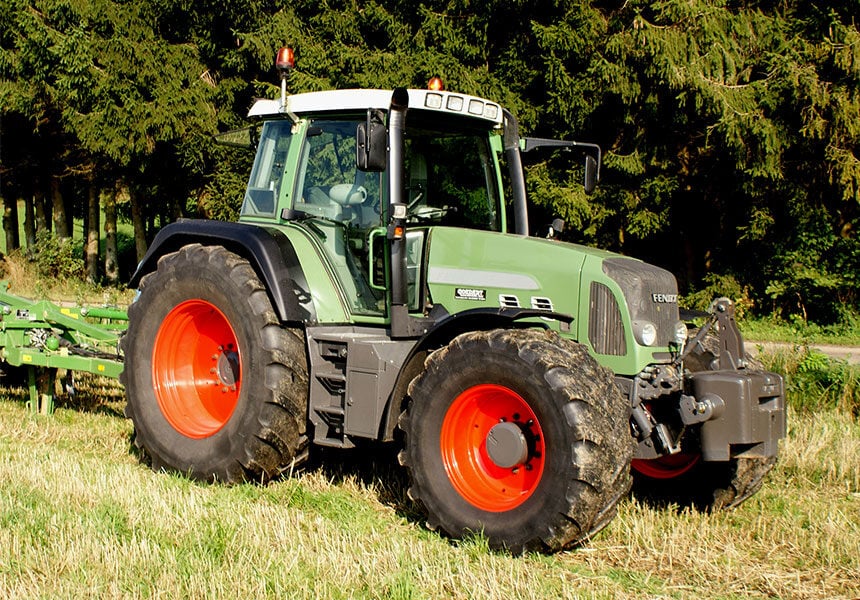
Fendt 817 Vario
165 hp - 121 kw – Tare weight: 7600 kg
| Front dimensions |
Profiles and technology | Rim width | Performance index | Rolling circumference (mm) | Pressure 1 bar at 15 km/h high torque | Pression 1.4 bar at 50 km/h |
| 420/85 R30 | VX | DW 15L | 145 D | 4400 | 2080 kg | 2620 kg |
| 480/70 R30 | VX | DW 15L | 147 D | 4442 | 2190 kg | 2485 kg |
| 540/65 R30 | VX | DW 16L | 150 D | 4422 | 2465 kg | 2690 kg |
| 540/65 R30 | VT (VF) | DW 18L | 155 D | 4337 | 2960 kg | 3570 kg |
| 600/65 R28 | VT (VF) | DW 21B | 159 D | 4406 | 3420 kg | 4050 kg |
| Rear dimensions |
Profiles and technology | Rim width | Performance index | Rolling circumference (mm) | Pressure 1 bar at 15 km/h high torque | Pression 1.4 bar at 50 km/h |
| 520/85 R42 | VX | DW 18L | 162 D | 5845 | 3390 kg | 3945 kg |
| 580/70 R42 | VX | DW 18L | 162 D | 5647 | 3330 kg | 4060 kg |
| 650/65 R42 | VX | DW 20B | 165 D | 5753 | 3790 kg | 4160 kg |
| 650/65 R42 | VT (VF) | DW 23B | 170 D | 5734 | 4590 kg | 5530 kg |
| 650/75 R38 | VX | DW 23B | 169 D | 5759 | 4050 kg | 4695 kg |
| 650/75 R38 | VT (VF) | DW 23B | 175 D | 5738 | 5100 kg | 6340 kg |
| 620/70 R42 | VX | DW 20B | 166 D | 5850 | 3775 kg | 3735 kg |
| 620/70 R42 | VT (VF) | DW 23B | 172 D | 5757 | 4715 kg | 5750 kg |
| 710/70 R38 | VX | DW 23B | 171 D | 5895 | 4475 kg | 5105 kg |
| 710/70 R38 | VT (VF) | DW 25B | 178 D | 5749 | 5560 kg | 6845 kg |
These dimensions are merely given as examples. If you cannot find the right dimensions, don’t hesitate to consult your usual tyre dealer to obtain a complete list of all available sizes.
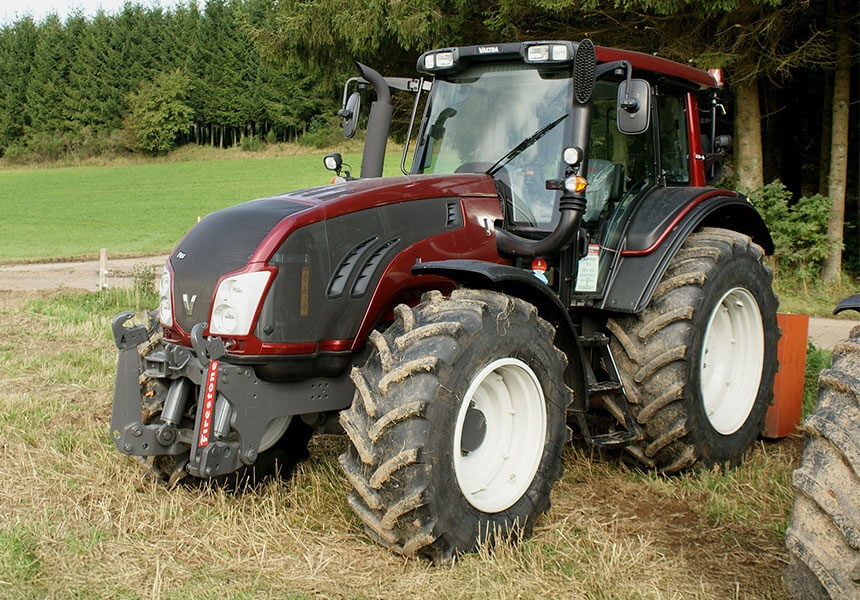
Valtra T 133
140 hp - 104 kw – Tare weight: 7200 kg
| Front dimensions |
Profiles and technology | Rim width | Performance index | Rolling circumference (mm) | Pressure 1 bar at 15 km/h high torque | Pression 1.4 bar at 50 km/h |
| 420/85 R28 | VX-R | DW 15L | 139 D | 4240 | 2015 kg | 2325 kg |
| 420/85 R28 | VX | DW 15L | 144 D | 4308 | 2025 kg | 2340 kg |
| 480/70 R28 | VX-R | DW 15L | 140 D | 4254 | 2070 kg | 2375 kg |
| 480/70 R28 | VX | DW 15L | 145 D | 4254 | 2090 kg | 2390 kg |
| 540/65 R28 | VX | DW 16L | 149 D | 4259 | 2335 kg | 2585 kg |
| 540/65 R28 | VT (VF) | DW 18L | 154 D | 4164 | 2855 kg | 3450 kg |
| Rear dimensions |
Profiles and technology | Rim width | Performance index | Rolling circumference (mm) | Pressure 1 bar at 15 km/h high torque | Pression 1.4 bar at 50 km/h |
| 520/85 R38 | VX-R | DW 18L | 155 D | 5466 | 3210 kg | 3710 kg |
| 520/85 R38 | VX | DW 18L | 155 D | 5530 | 3190 kg | 3720 kg |
| 580/70 R38 | VX-R | DW 18L | 155 D | 5503 | 3055 kg | 3710 kg |
| 580/70 R38 | VX | DW 18L | 160 D | 5408 | 3240 kg | 3715 kg |
| 650/65 R38 | VX-R | DW 20B | 157 D | 5466 | 3615 kg | 4000 kg |
| 650/65 R38 | VX | DW 20B | 163 D | 5413 | 3595 kg | 4020 kg |
| 650/65 R38 | VT (VF) | DW 23B | 169 D | 5424 | 4335 kg | 5310 kg |
| 800/65 R38 | VT-Combine (IF) | DW 27B | 178 A8 | 5489 | 7930 kg | 5285 kg |
These dimensions are merely given as examples. If you cannot find the right dimensions, don’t hesitate to consult your usual tyre dealer to obtain a complete list of all available sizes.
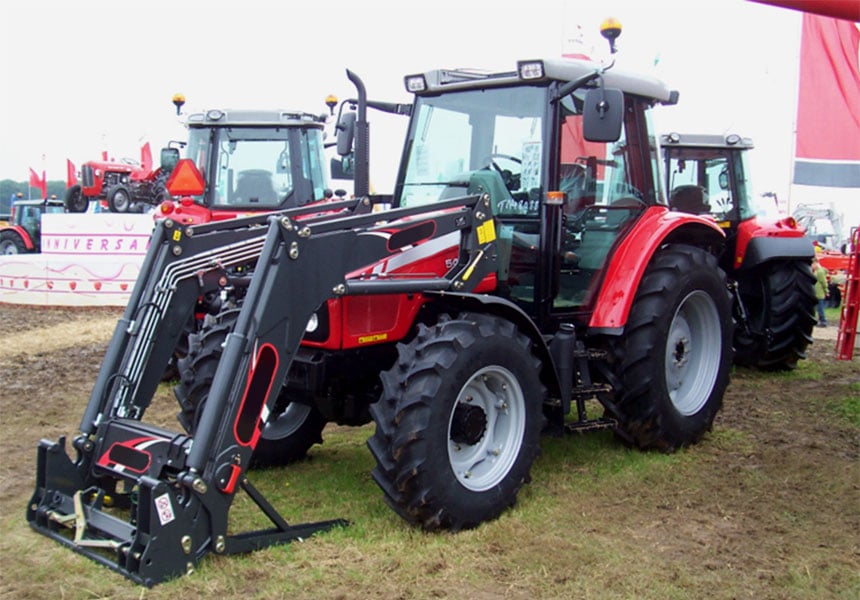
Massey Ferguson 5440
100 hp - 75 kw – Tare weight: 3900 kg
| Front dimensions |
Profiles and technology | Rim width | Performance index | Rolling circumference (mm) | Pressure 1 bar at 15 km/h high torque | Pression 1.4 bar at 50 km/h |
| 340/85 R24 | VX-R | DW 12 | 125 D | 3570 | 1370 kg | 1580 kg |
| 340/85 R24 | VX | DW 12 | 130 D | 3555 | 1390 kg | 1590 kg |
| 380/70 R24 | VX-R | DW 12 | 125 D | 3546 | 1370 kg | 1590 kg |
| 380/70 R24 | VX | DW 12 | 130 D | 3575 | 1375 kg | 1595 kg |
| 440/65 R24 | VX-R | DW 14L | 128 D | 3499 | 1580 kg | 1745 kg |
| 440/65 R24 | VX | DW 14L | 135 D | 3538 | 1585 kg | 1670 kg |
| Rear dimensions |
Profiles and technology | Rim width | Performance index | Rolling circumference (mm) | Pressure 1 bar at 15 km/h high torque | Pression 1.4 bar at 50 km/h |
| 420/85 R34 | VX-R | DW 15L | 142 D | 4714 | 2195 kg | 2535 kg |
| 420/85 R34 | VX | DW 15L | 147 D | 4733 | 2215 kg | 2550 kg |
| 480/70 R34 | VX-R | DW 15L | 143 D | 4753 | 2255 kg | 2610 kg |
| 480/70 R34 | VX | W 15L | 149 D | 4700 | 2310 kg | 2620 kg |
| 540/65 R34 | VX | DW 16L | 152 D | 4709 | 2615 kg | 2850 kg |
| 540/65 R34 | VT (VF) | DW 18L | 157 D | 4625 | 3135 kg | 3790 kg |
These dimensions are merely given as examples. If you cannot find the right dimensions, don’t hesitate to consult your usual tyre dealer to obtain a complete list of all available sizes.

New Holland TS 90
90 hp - 65 kw – Tare weight: 3300 kg
| Front dimensions |
Profiles and technology | Rim width | Performance index | Rolling circumference (mm) | Pressure 1 bar at 15 km/h high torque | Pression 1.4 bar at 50 km/h |
| 340/85 R24 | VX-R | DW 12 | 125 D | 3570 | 1370 kg | 1580 kg |
| 340/85 R24 | VX | DW 12 | 130 D | 3555 | 1390 kg | 1590 kg |
| 380/70 R24 | VX-R | DW 12 | 125 D | 3546 | 1370 kg | 1510 kg |
| 380/70 R24 | VX | DW 12 | 130 D | 3575 | 1375 kg | 1595 kg |
| 440/65 R24 | VX-R | DW 14L | 135 D | 3438 | 1580 kg | 1745 kg |
| 440/65 R24 | VX | DW 14L | 135 D | 3538 | 1585 kg | 1755 kg |
| Rear dimensions |
Profiles and technology | Rim width | Performance index | Rolling circumference (mm) | Pressure 1 bar at 15 km/h high torque | Pression 1.4 bar at 50 km/h |
| 420/85 R34 | VX-R | DW 15L | 142 D | 4714 | 2195 kg | 2535 kg |
| 420/85 R34 | VX | DW 15L | 147 D | 4733 | 2215 kg | 2550 kg |
| 480/70 R34 | VX-R | DW 15L | 143 D | 4753 | 2255 kg | 2610 kg |
| 480/70 R34 | VX | W 15L | 149 D | 4700 | 2310 kg | 2620 kg |
| 540/65 R34 | VX | DW 15L | 152 D | 4709 | 2615 kg | 2850 kg |
| 540/65 R34 | VT (VF) | DW 18L | 157 D | 4625 | 3135 kg | 3790 kg |
These dimensions are merely given as examples. If you cannot find the right dimensions, don’t hesitate to consult your usual tyre dealer to obtain a complete list of all available sizes.
5. Pay attention to lead for optional functioning
What is lead?
Lead is the difference in rotation speed between the front and rear wheels of your vehicle, if your tractor has four drive wheels which are not all the same size.
A lead ratio of between 0.5% and 5% is generally considered as normal. Optimal lead settings, around 2.5%, guarantee good traction, even tyre wear and optimised fuel consumption.
Consequences of incorrect lead:
Badly adjusted lead can have major repercussions on your tractor and your work:
- Premature wear to front tyres: if the lead ratio is too high, the front wheels pull excessively, which causes premature wear to their lugs.
- Extra fuel consumption: an imbalance in the wheel rotation speed increases rolling resistance and as such fuel consumption.
- Mechanical risks (damage to the pinions, front axle): a lead ratio that is too low or too high can place considerable strain on certain transmission components, leading to premature mechanical breakdowns.
How to check?
To check lead, you need to know:
- Your tractor’s drive ratio
- The exact rolling circumference of each tyre.
Once you have this information, you simply need to apply the following formula to calculate the lead ratio:

You can also use online calculators or charts supplied by tyre manufacturers to determine the theoretical lead.
When you replace your tyres, it is essential to recalculate the lead ratio, because the rolling circumference may vary from one tyre to another, even if they have the same nominal dimensions.
Practical advice:
- Give priority to tyres of the same brand and range to reduce the risk of differences in circumference.
- Be aware that beyond the theoretical dimensions, lead may vary based on pressure, technology (IF- VF) and the extent of tyre wear.
- Turn to a professional for advice if you have any doubts.
CONCLUSION:
The choice of agricultural tyres is not a decision to be taken lightly. It represents an investment that will have a direct impact on the efficiency of your tractor, your productivity, your profitability and the health of your soil.
There are many advantages to be gained from opting for the right tyre dimensions and profiles.
To optimise your performance capacity, consult the correspondence tables supplied above in order to find the perfect tyres for your tractor.
Don’t hesitate to contact us to ask for expert advice.
The Bridgestone-agriculture.eu blog is written and administered by tractor tyre experts who are available to provide you with the advice you need on the subject of your agricultural tyres. They allow you to maximise your productivity with information on all subjects linked to tyres: Technical data for agricultural tyres – Agricultural tyre performance – Air pressure advice, Solutions to avoid soil compaction – Sprayer tyre pressure – Why and how to ballast your tractor tyres – etc.
To take it one step further and increase the profitability of your farm, the blog Bridgestone-agriculture.eu provide a free, highly detailed eBook which explains the essential role of the agricultural tyre in your productivity.
Most people who read this article have also read some of the following articles which are listed by order of popularity:
- Buying guide: 10 important tips for choosing the right farming tyres
- Here is the new generation of high-tech agricultural tyres
- Testimonial: What are the qualities of a premium agricultural tyre
- What is the best agricultural tyre for autonomous tractors?
- Which agricultural tyre boosts the performance of your agricultural contracting company?
- Good agricultural tyre option choices when buying your new tractor
- Farmer testimonials on Bridgestone agricultural tyres
- What are the advantages of a high-tech IF VF CFO tyre?
- How can a good agricultural tyre improve your profitability?
- Here are your best testimonials about our agricultural tyres
This information is intended only to make you aware of the technical and functional aspects of agricultural tires and their use. It does not allow you to make a judgment or a definitive conclusion on a given problem. Only your agricultural tire expert is able to make a technical assessment and take a final decision, case by case.
Leave a
commentary
Your email address will not be published.
Required fields are indicated with *



